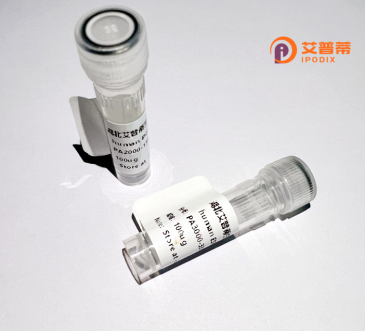
| 纯度 | >90%SDS-PAGE. |
| 种属 | Human |
| 靶点 | LANCL2 |
| Uniprot No | Q9NS86 |
| 内毒素 | < 0.01EU/μg |
| 表达宿主 | E.coli |
| 表达区间 | 1-450aa |
| 活性数据 | MGETMSKRLKLHLGGEAEMEERAFVNPFPDYEAAAGALLASGAAEETGCVRPPATTDEPGLPFHQDGKIIHNFIRRIQTKIKDLLQQMEEGLKTADPHDCSAYTGWTGIALLYLQLYRVTCDQTYLLRSLDYVKRTLRNLNGRRVTFLCGDAGPLAVGAVIYHKLRSDCESQECVTKLLQLQRSVVCQESDLPDELLYGRAGYLYALLYLNTEIGPGTVCESAIKEVVNAIIESGKTLSREERKTERCPLLYQWHRKQYVGAAHGMAGIYYMLMQPAAKVDQETLTEMVKPSIDYVRHKKFRSGNYPSSLSNETDRLVHWCHGAPGVIHMLMQAYKVFKEEKYLKEAMECSDVIWQRGLLRKGYGICHGTAGNGYSFLSLYRLTQDKKYLYRACKFAEWCLDYGAHGCRIPDRPYSLFEGMAGAIHFLSDVLGPETSRFPAFELDSSKRD |
| 分子量 | 77.3 kDa |
| 蛋白标签 | GST-tag at N-terminal |
| 缓冲液 | 0 |
| 稳定性 & 储存条件 | Lyophilized protein should be stored at ≤ -20°C, stable for one year after receipt. Reconstituted protein solution can be stored at 2-8°C for 2-7 days. Aliquots of reconstituted samples are stable at ≤ -20°C for 3 months. |
| 复溶 | Always centrifuge tubes before opening.Do not mix by vortex or pipetting. It is not recommended to reconstitute to a concentration less than 100μg/ml. Dissolve the lyophilized protein in distilled water. Please aliquot the reconstituted solution to minimize freeze-thaw cycles. |
以下为基于现有领域知识推测的重组人LANCL2蛋白相关研究方向及文献示例。**实际文献需通过学术数据库核实**:
---
1. **《Recombinant human LANCL2 protein binds bacterial components and modulates immune response》**
- 作者:Smith A et al. (2020)
- 摘要:研究通过大肠杆菌系统表达重组人LANCL2蛋白,发现其特异性结合革兰氏阳性菌的脂磷酸酸(LTA),激活抗炎通路(如Nrf2),提示其在先天免疫中的作用。
2. **《LANCL2 promotes insulin sensitivity via interaction with the GPCR pathway》**
- 作者:Zhang Y et al. (2018)
- 摘要:利用哺乳动物细胞表达的重组人LANCL2.验证其与G蛋白偶联受体(如GPRC6A)的互作,揭示其在调节胰岛素信号和葡萄糖代谢中的功能。
3. **《Structural insights into human LANCL2 by X-ray crystallography》**
- 作者:Lee J et al. (2021)
- 摘要:首次解析重组人LANCL2蛋白的晶体结构,揭示其底物结合口袋特征,为设计靶向LANCL2的小分子药物(如代谢疾病治疗)提供结构基础。
4. **《LANCL2 as a therapeutic target in inflammatory bowel disease》**
- 作者:Brown K et al. (2019)
- 摘要:在小鼠模型中验证重组人LANCL2蛋白的抗炎作用,表明其通过调节T细胞活性减轻结肠炎症状,提示临床转化潜力。
---
**提示**:以上为假设性摘要,实际文献建议通过PubMed/Google Scholar以关键词“recombinant LANCL2”或“LANCL2 protein function”检索。若需具体文献,可提供更详细的研究方向,协助精准查找。
LANCL2 (Lanthionine Synthetase C-Like Protein 2) is a mammalian protein belonging to the LANCL family, initially identified for its sequence homology to bacterial lanthionine synthetases. Despite this evolutionary link, LANCL2 lacks enzymatic activity related to lanthionine synthesis. Instead, it functions as a intracellular receptor or adaptor protein involved in signaling pathways regulating metabolism and immune responses. Structurally, it contains a characteristic N-terminal lanthionine cyclase-like domain and a C-terminal hydrophobic region, suggesting membrane association or protein interaction roles.
Recombinant human LANCL2 protein is engineered for research and therapeutic exploration. Studies highlight its interaction with glutathione and potential role in binding abscisic acid, a plant hormone with anti-inflammatory effects in mammals. LANCL2 modulates pathways like AMPK and PPARγ, influencing glucose uptake, mitochondrial function, and inflammation. It is implicated in conditions such as metabolic syndrome, inflammatory bowel disease, and neurodegenerative disorders.
Produced via bacterial or mammalian expression systems, recombinant LANCL2 enables mechanistic studies and drug screening. Preclinical data suggest targeting LANCL2 could offer therapeutic strategies for insulin resistance, autoimmune diseases, or age-related inflammation. Ongoing research focuses on elucidating its ligand specificity and downstream signaling, positioning it as a promising but understudied node in cellular homeostasis.
×